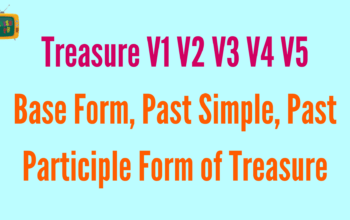Connote V1 V2 V3 V4 V5 is one of the verbs that are used very commonly in English tests as well as in everyday communication. Also, because it’s an irregular verb, connote doesn’t follow the regular rule. The verb “connote” has five different forms: base form, past simple, past participle form, present perfect, and present perfect participle. So what is connote‘s past? How do conjugate verbs with connote verbs?
⏩ Sign Up to Get Bonus
Let’s find out with English tivi in the article below.
See more at: Verbs
Connote of Definition and Meaning
The term connote is used to describe the meaning of something. A connote is a word or phrase that conveys the meaning of a concept, idea, or term. It has been used by people for ages and it has been used in many different contexts.
V1 V2 V3 V4 V5 Form of Connote
| Base Form (V1) | connote |
| Past Form (V2) | connoted |
| Past Participle Form (V3) | connoted |
| s / es/ es (V4) | connotes |
| ‘ing’ form (V5) | connoting |
Connote of Past Simple V2
The verb Connote is also employed in its V2 form as “connoted”’. It is used to indicate the past tense in sentences.
Connote of Past Participle V3
The V3 form is identical to the V2 form. The V3 form is “connoted”. Connoted is used in the past or present perfect tense.
+ In the present perfect tense, we use the word V1 as ‘have + connoted‘ or ‘has + connoted'.
- I, you, and we are used as ‘have + connoted‘.
- ‘has + connoted' is used for he, she, and it.
+ If you need to use the past perfect tense, use ‘had + connoted‘ regardless of the subject.
You might also like: ALL the English Grammar Basics You Need
Conjugation of Connote V1 V2 V3 V4 V5
| Conjugation table: Connote | |||
| Number | Singular | ||
| Present Simple of connote | I | You | She/He/It |
| connote | connote | connotes | |
| Plural | |||
| We | You | They | |
| connote | connote | connote | |
| Present Continuous of connote | I | You | She/He/It |
| am connoting | are connoting | is connoting | |
| Plural | |||
| We | You | They | |
| are connoting | are connoting | are connoting | |
| Present Perfect of connote | I | You | She/He/It |
| have connoted | have connoted | has connoted | |
| Plural | |||
| We | You | They | |
| have connoted | have connoted | have connoted | |
| Present Perfect Continuous of connote | I | You | She/He/It |
| have been connoting | have been connoting | has been connoting | |
| Plural | |||
| We | You | They | |
| have been connoting | have been connoting | have been connoting | |
| Past Simple of connote | I | You | She/He/It |
| connoted | connoted | connoted | |
| Plural | |||
| We | You | They | |
| connoted | connoted | connoted | |
| Past Continuous of connote | I | You | She/He/It |
| was connoting | were connoting | was connoting | |
| Plural | |||
| We | You | They | |
| were connoting | were connoting | were connoting | |
| Past Perfect of connote | I | You | She/He/It |
| had connoted | had connoted | had connoted | |
| Plural | |||
| We | You | They | |
| had connoted | had connoted | had connoted | |
| Past Perfect Continuous of connote | I | You | She/He/It |
| had been connoting | had been connoting | had been connoting | |
| Plural | |||
| We | You | They | |
| had been connoting | had been connoting | had been connoting | |
| Future Simple of connote | I | You | She/He/It |
| will/shall connote | will/shall connote | will/shall connote | |
| Plural | |||
| We | You | They | |
| will/shall connote | will/shall connote | will/shall connote | |
| Future Continuous of connote | I | You | She/He/It |
| will/shall be connoting | will/shall be connoting | will/shall be connoting | |
| Plural | |||
| We | You | They | |
| will/shall be connoting | will/shall be connoting | will/shall be connoting | |
| Future Perfect of connote | I | You | She/He/It |
| will/shall have connoted | will/shall have connoted | will/shall have connoted | |
| Plural | |||
| We | You | They | |
| will/shall have connoted | will/shall have connoted | will/shall have connoted | |
| Future Perfect Continuous of connote | I | You | She/He/It |
| will/shall have been connoting | will/shall have been connoting | will/shall have been connoting | |
| Plural | |||
| We | You | They | |
| will/shall have been connoting | will/shall have been connoting | will/shall have been connoting | |
| Conditional Present of connote | I | You | She/He/It |
| would connote | would connote | would connote | |
| Plural | |||
| We | You | They | |
| would connote | would connote | would connote | |
| Conditional Perfect of connote | I | You | She/He/It |
| would have connoted | would have connoted | would have connoted | |
| Plural | |||
| We | You | They | |
| would have connoted | would have connoted | would have connoted | |
| Conditional Present Continuous of connote | I | You | She/He/It |
| would be connoting | would be connoting | would be connoting | |
| Plural | |||
| We | You | They | |
| would be connoting | would be connoting | would be connoting | |
| Conditional Perfect Continuous of connote | I | You | She/He/It |
| would have been connoting | would have been connoting | would have been connoting | |
| Plural | |||
| We | You | They | |
| would have been connoting | would have been connoting | would have been connoting | |
| Present Subjunctive of connote | I | You | She/He/It |
| connote | connote | connote | |
| Plural | |||
| We | You | They | |
| connote | connote | connote | |
| Past Subjunctive of connote | I | You | She/He/It |
| connoted | connoted | connoted | |
| Plural | |||
| We | You | They | |
| connoted | connoted | connoted | |
| Past Perfect Subjunctive of connote | I | You | She/He/It |
| had connoted | had connoted | had connoted | |
| Plural | |||
| We | You | They | |
| had connoted | had connoted | had connoted | |
| Imperative of connote | I | You | She/He/It |
| connote | |||
| Plural | |||
| We | You | They | |
| Let’s connote | connote | ||
See more at: Vocabulary
Example Sentences with Connote V1 V2 V3 V4 V5
In this section, we will learn about connote sentence examples:
- Chocolate connotes feelings of pleasure and indulgence in me.
- We play together doesn't connote we're close.
Synonym Words For Connote
Synonym of connote word list. Here are a variety of words whose meaning is nearly the synonym of connote:
- indicate
- imply
- suggest
- signify
- denote
- intimate
- insinuate
- mean
- express
- signal
- betoken
- import
- purport
- evidence
Opposite Words For Connote
The antonym of connote word list. Here are some words that have nearly the opposite meaning as connote:
- denote
- conceal
- hide
- mean
- refuse
- suppress
- deny
- withhold
- listen
- refrain
- leave alone
- stifle
- mumble
- be quiet
- cover
- lose
You might also like: Best List of Irregular Verbs in English
Some Frequently Asked Questions About Connote (Verb)
What is the V1 V2 V3 V4 V5 of connote?
The past tense of connote is connoted. The third-person singular simple present indicative form of connote is connotes. The present participle of connote is connoting. The past participle of connote is connoted.
| Base Form (V1) | connote |
| Past Form (V2) | connoted |
| Past Participle Form (V3) | connoted |
| s / es/ es (V4) | connotes |
| ‘ing’ form (V5) | connoting |
What is the V2 and V3 form of connote?
+ The V2 and V3 form of connote is “connoted“.
What is the sentence of connote?
What is the past tense V2 of connote?
+ The past tense of connote is “connoted“.
What is the past participle V3 of connote?
+ The past participle of connote is “connoted“.
What is the present participle V5 of connote?
+ The present participle of connote is “connoting“.
Conclusion
Let’s learn with English TV the structure of the verb “Connote V1 V2 V3 V4 V5“: Base Form, Past Simple, Present Continuous and Present Continuous and Present Continuous and Present Continuous forms. We wish you all the best of luck.
You should subscribe to the English TV YouTube channel if you want to learn more about the English language and improve your proficiency.





